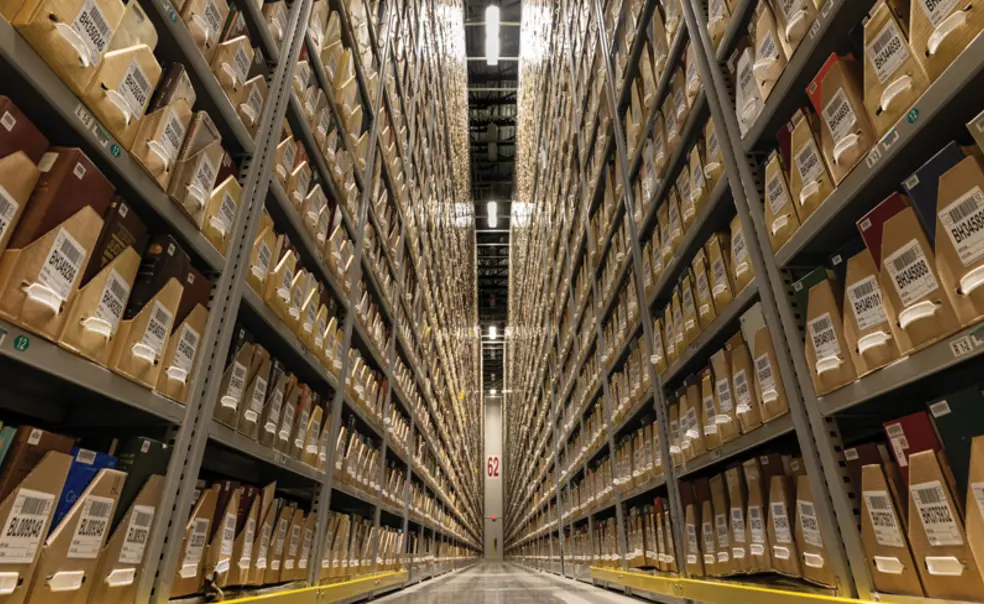There’s a Massive Ivy League Library Warehouse Across Route 1
ReCAP provides storage — and retrieval — for millions of items from multiple Ivy libraries
With just a simple search of the Princeton University Library catalog, you can view and request materials from Harvard, Columbia, and Yale universities without realizing they aren’t housed at Princeton. Many of those requests are directed to a roughly 200,000-square-foot building just a few miles from the core of campus that has more than eight times the physical inventory of Firestone Library: the Research Collections and Preservation Consortium, known as ReCAP, a nonprofit jointly owned and operated by five member libraries, including Princeton.
Once a request is submitted for an item at ReCAP, the system shows staff exactly where to locate the item in the vast collection, which is organized by originating library, then by size. Items are stored in open-top, acid-free trays along aisles more than 200 feet long and nearly 40 feet high, and staff use order pickers — similar to forklifts — to collect requests from the shelves three times a day. Rather than a library or bookstore, the vast space is evocative of an endless sterile warehouse.
A borrower will receive their item within two business days, an impressive feat given that the Forrestal Campus facility holds more than 18 million total items, making it “one of the world’s largest library and archives preservation repositories,” according to ReCAP’s website. The consortium, which also includes the New York Public Library, was established in 2000 and enables member libraries to share inventory “as seamless[ly] as possible for the user,” ReCAP Executive Director Ian Bogus told PAW.
“You’re not going to know that something is owned by someone else until it arrives in your hands and it’s got stamps from a different library,” Bogus said.
In addition to books and historical documents, ReCAP houses computer discs, LPs, VHS tapes, and DVDs, as well as acetate film, which is kept in a cold storage vault at around 35 degrees to slow degradation. The rest of the storage space hovers around a balmy 52 degrees, which allows items to “last about four to five times longer” than in average libraries, according to Bogus.
Princeton’s ReCAP facility includes eight storage modules and a central processing area (which is kept at a warmer temperature for staff). Last year, the staff filled about 215,000 physical requests, meaning nearly 500,000 transactions in which an item is sent or received. Staff handle about 500 items per hour, ranging from reels of The Godfather to 100-year-old, intricate maps of New York City.
Asim Curevac, an operations coordinator who joined ReCAP in 2002, remembers handling a collection of old Bibles once. There are “not many places like this,” he told PAW via email.
Bogus said prior to the COVID-19 pandemic, ReCAP was lending even more, but there is now a stronger preference for digital deliveries. Last year, staff members fulfilled about 20,000 digital deliveries — scanning and sending one chapter, one article, 50 pages, or 10% of an item.
There are also long-term projects, like cataloging and archival processing — this year, they’ll send about 55,000 New York Public Library items to Google for scanning.
The nearly two dozen staff who work at the site are Princeton University employees, though the building and land are owned by the consortium. A second ReCAP facility, in Massachusetts and hosted by Harvard, holds another 10 million items, all of which are owned by Harvard.
Even though other libraries have inquired about membership, “I think we view the consortium [as] complete,” Bogus said, with the addition of Yale, which joined this summer. “I think that Yale was a special circumstance,” he added, because of its similar size and scope as the other ReCAP members.
It’s up to each member library as to what they want to store at ReCAP, but the most frequently requested items tend to stay at the home institutions. Partners sometimes coordinate to reduce the number of duplicate items in ReCAP’s collection, but there is no policy against duplicates, and Bogus said it can be “more economical to just keep building” storage space.
ReCAP has never lost an item, according to Bogus, and over the years, only about 50,000 items have been deaccessioned, most of which were old business records.
“ReCAP is an exemplar of what can be achieved when we work together,” said Anne Jarvis, the dean of libraries at Princeton, in a University announcement about Yale joining.
Even though ReCAP added about 400,000 new items to the Princeton facility last year — its average yearly intake — there is still more room to grow. Last summer, construction was completed on a still vacant addition that will allow ReCAP to store another 6 million items.
Even with bare shelves, ReCAP is looking further ahead. “We have land for two more modules, and we are also exploring other options that could serve us for years to come,” Bogus said.














No responses yet